Key takeaways:
- Hospital ministry involves providing emotional and spiritual support to patients and families, emphasizing the importance of addressing individual spiritual needs during health crises.
- Engaging learners through interactive activities, personal storytelling, and fostering community enhances understanding and retention of important concepts in hospital ministry.
- Creating a welcoming environment is essential for meaningful dialogue, which includes thoughtful physical arrangements and acknowledging individual experiences.
- Facilitating group discussions and reflecting on personal experiences foster empathy and strengthen connections among participants, promoting shared healing and resilience.
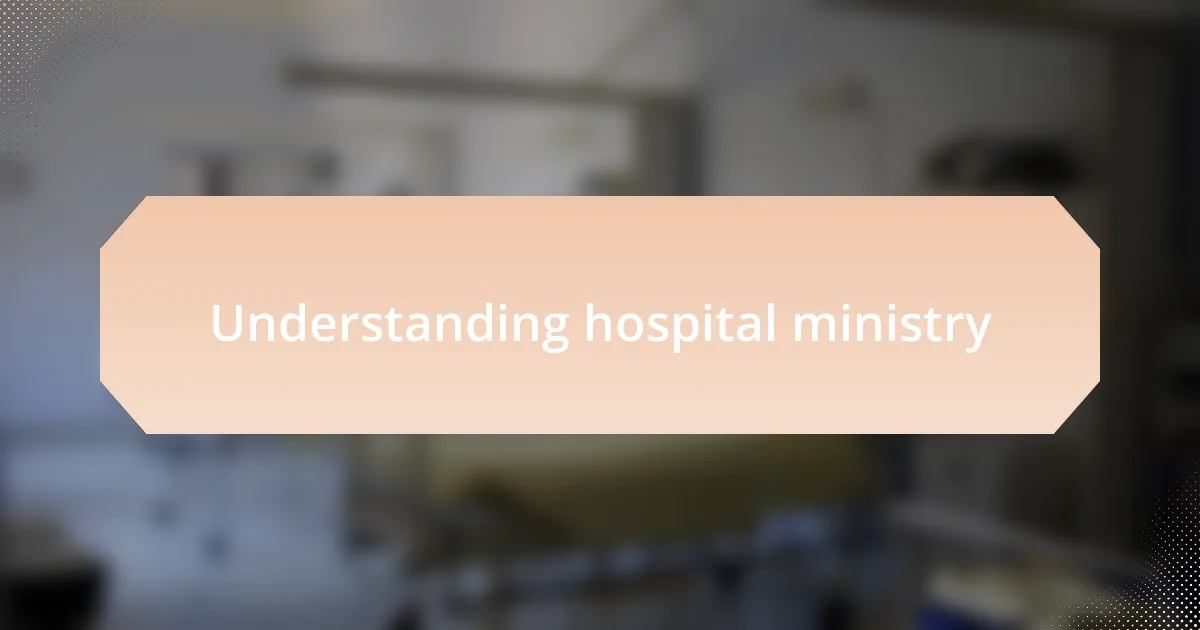
Understanding hospital ministry
Hospital ministry is a unique branch of spiritual care that encompasses providing emotional and spiritual support to patients and their families during some of life’s most challenging moments. I often reflect on my own experiences visiting patients; it’s a profound opportunity to witness their vulnerability and strength. Have you ever felt the weight of uncertainty in a hospital setting? That shared humanity can be incredibly powerful.
In this context, hospital ministers act as compassionate liaisons, bridging the gap between patients’ spiritual beliefs and their medical experiences. I remember speaking with a patient who shared how a simple prayer lifted their spirits on a particularly tough day. It made me realize how important it is to address not just physical health but also the soul’s well-being.
Understanding hospital ministry involves recognizing the diverse spiritual needs of individuals facing health crises. Every visit offers a chance to connect deeply, listen actively, and support healing beyond the body. How do you approach a situation when someone is in despair? For me, it’s about being present and offering a listening ear, which often opens doors to meaningful conversations.
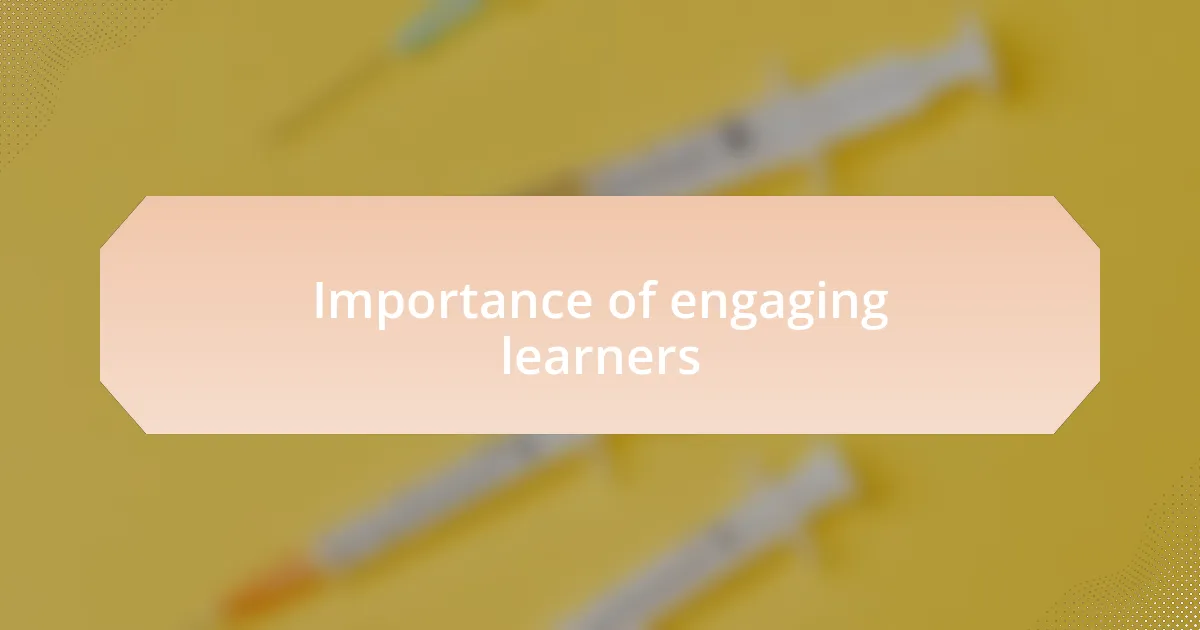
Importance of engaging learners
Engaging learners is crucial in any educational setting, especially within hospital ministry. I remember a time when I facilitated a discussion among medical staff about the importance of empathy in patient care. The moment they began to share their own experiences and challenges, I witnessed a transformation in the room—learning became a shared journey rather than a one-sided lecture.
When learners feel engaged, they’re more likely to absorb and retain information. For instance, in a workshop I led on spiritual assessments, I encouraged participants to role-play different patient scenarios. This hands-on approach ignited lively discussions and allowed each attendee to reflect on how they would apply their learnings in real situations. Have you ever noticed how much more impactful a lesson can be when you’re actively involved?
Moreover, engaging learners fosters a sense of community and belonging. I recall a support group I organized where each participant shared their story. It was remarkable to see how their vulnerability created connections, enriching everyone’s understanding. In moments like these, I realized that the act of engaging isn’t just about delivering knowledge; it’s about nurturing relationships that can enhance the healing process.
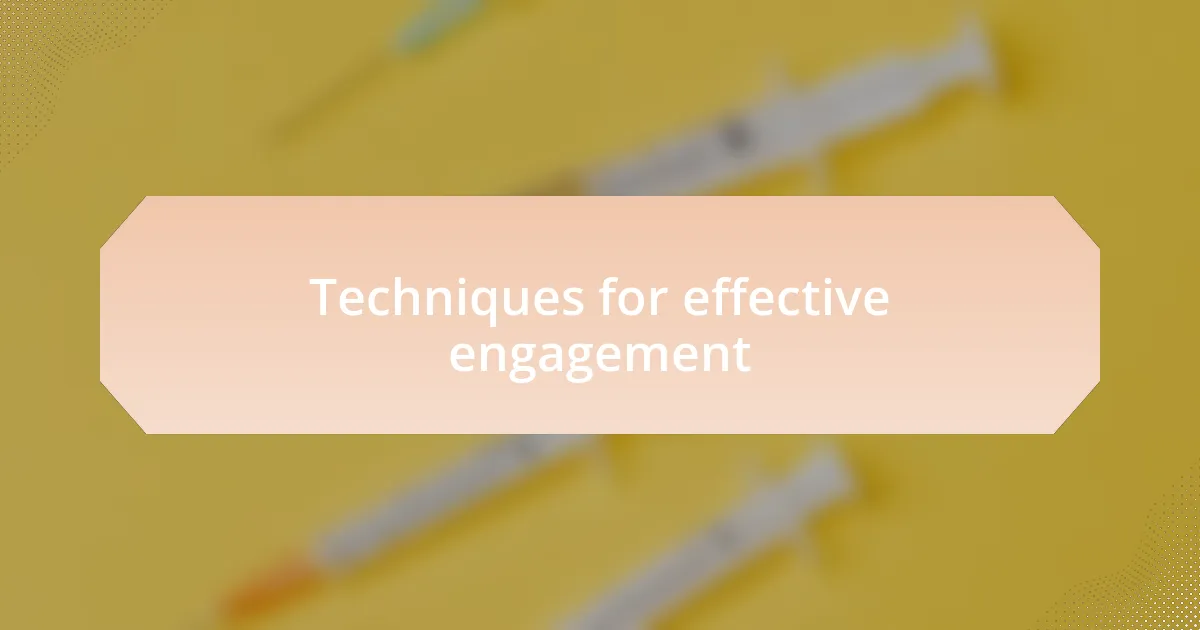
Techniques for effective engagement
Utilizing interactive activities can significantly enhance the engagement of learners. I fondly recall a session where I introduced a group game centered around communication styles in patient care. The laughter and intrigue that filled the room drew everyone in; it was as if we were not just learning but enjoying a collaborative adventure. Have you felt that buzz of energy when everyone is fully participating? It sparks not only excitement but deeper understanding.
Another effective technique involves personal storytelling. One time, I shared my own experience of comforting a patient facing a terminal diagnosis. The room fell silent; in that moment, we connected on a profound level, and I could see the empathy blooming in their faces. Personal stories can bridge the gap between theory and practice, allowing learners to visualize how abstract concepts apply in real-world situations.
Finally, integrating technology can bring a modern twist to your engagement strategies. During a recent online seminar, I used polls to gauge real-time responses about ethical dilemmas in care. The feedback was instantaneous and sparked lively discussions, making it more than just a digital lecture. How empowering it is when technology amplifies our voices and brings us closer together, even from a distance!
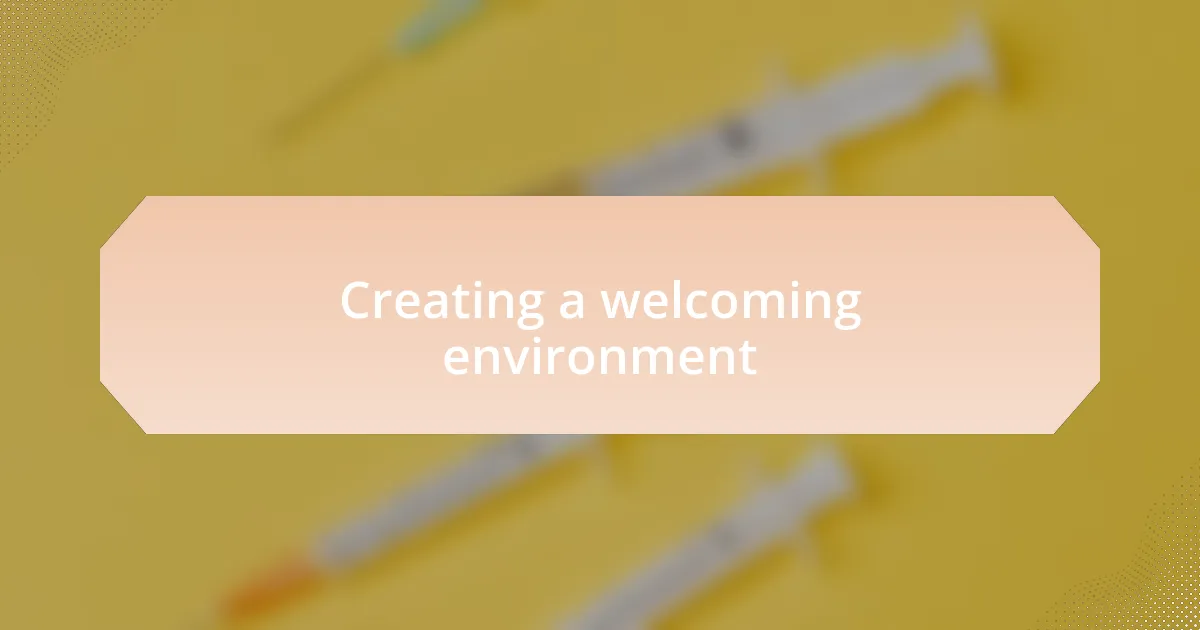
Creating a welcoming environment
Creating a welcoming environment is foundational to fostering engagement. When I first entered a hospital ministry, I noticed how a simple smile and a warm greeting could transform the atmosphere. It’s remarkable how much a genuine approach can make participants feel valued and ready to share their thoughts. Have you ever walked into a room and felt the difference a friendly face can make?
Moreover, the physical setup of the space can significantly impact how welcome someone feels. I once rearranged chairs in a circle rather than in rows and immediately sensed a shift. The change encouraged open dialogue and created an intimacy that made discussions feel safe and personal. Imagine how much more willing people are to share when they feel like they’re in a space designed for connection rather than just instruction.
Lastly, acknowledging each individual’s unique experiences fosters an inclusive atmosphere. I remember taking a moment in a session to hold an open floor for anyone to share what brought them to hospital ministry. It was enlightening; hearing diverse stories reminded us all of our shared mission. How often do we overlook the importance of each person’s journey in creating a truly welcoming environment?
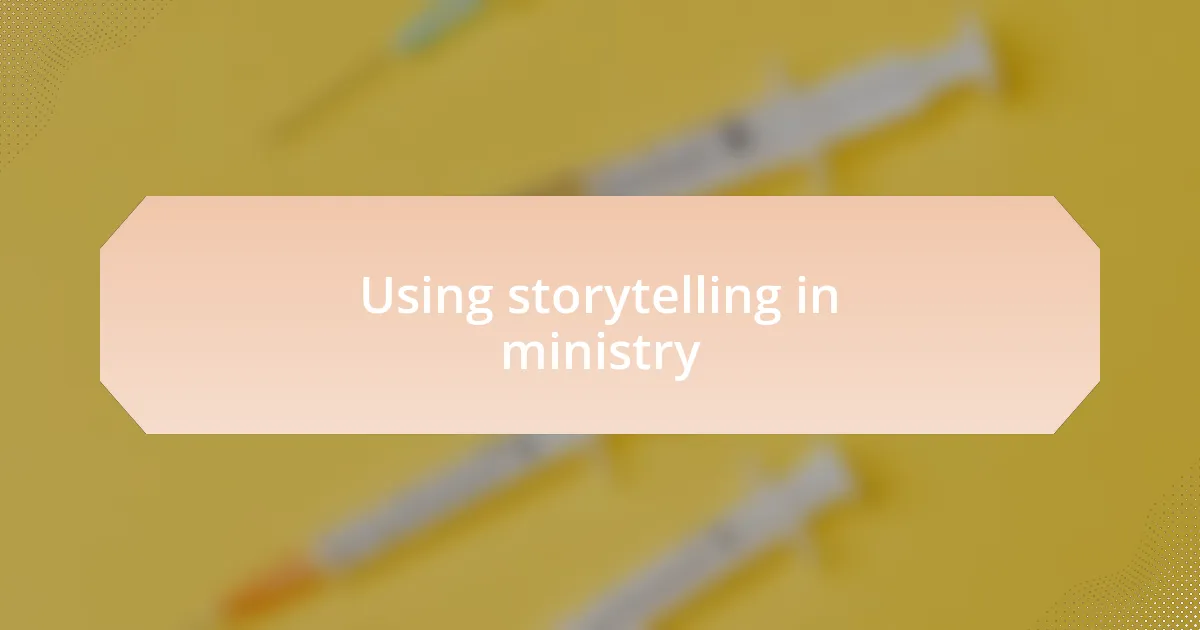
Using storytelling in ministry
Storytelling in ministry serves as a powerful tool to connect with learners on a deeper emotional level. I recall a time when I shared a personal story about a patient whose journey transformed my perspective on life and faith. The room fell silent as the participants listened intently, their expressions reflecting a shared vulnerability. Have you ever experienced how a well-told story can bridge gaps in understanding and foster genuine empathy?
When crafting narratives, it’s essential to weave in lessons that resonate with our shared experiences. I’ve found that incorporating elements of hope or redemption can uplift spirits. Once, during a group meeting, I recounted a challenging period in my life and how it led to unexpected blessings. The room became a safe haven as others began to open up about their struggles, realizing they weren’t alone. How often do we underestimate the healing power of sharing?
Moreover, storytelling allows us to contextualize complex spiritual concepts in relatable ways. I often use stories from scripture alongside contemporary examples to illustrate teachings. For instance, after recounting the parable of the Good Samaritan, I invited participants to reflect on their own lives. Have you thought about moments where you could play the role of a helper? These discussions illuminate paths of action and inspire individuals to embody the teachings more actively.
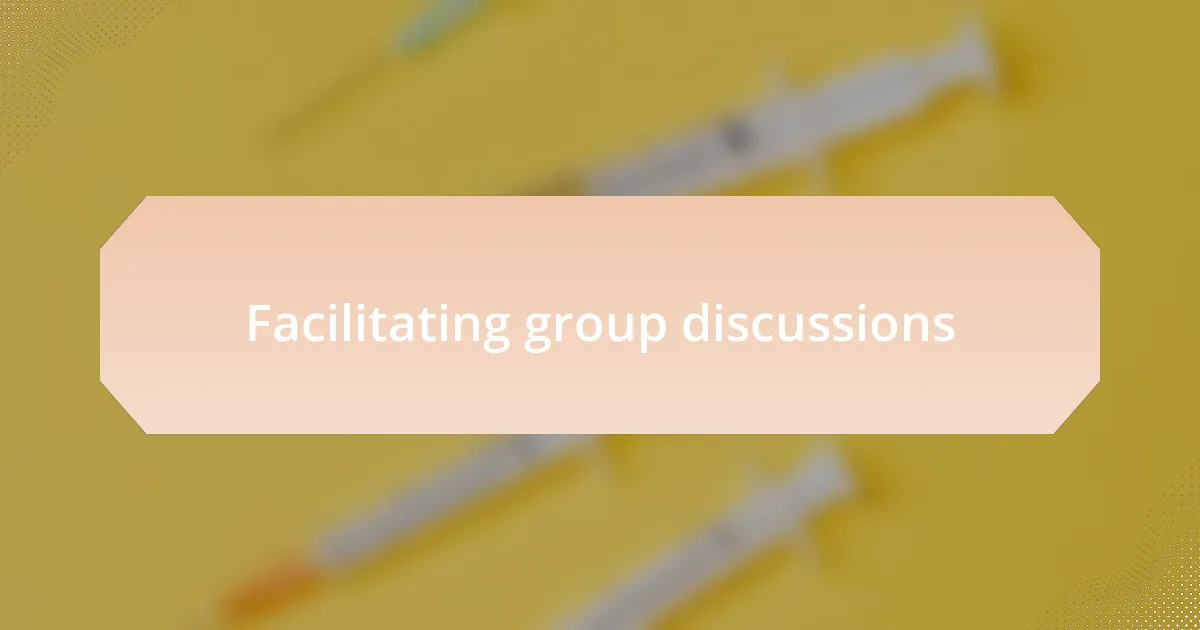
Facilitating group discussions
Facilitating group discussions can be incredibly rewarding, as it often leads to unexpected insights and personal growth. I remember a particular discussion where we focused on the importance of community support in times of grief. Participants shared their own experiences and how they found solace in the company of others. It’s fascinating, isn’t it, how a single topic can draw out such profound reflections from people?
Creating a safe environment is critical for encouraging open dialogue. I’ve found that starting with a simple icebreaker question can ease tension and set the tone. For example, once, I asked everyone to share a favorite memory related to kindness they received during a tough time. The warmth that filled the room was palpable; participants began nodding and smiling, ready to contribute more actively. Can you recall a moment when your voice made a difference in someone else’s life?
Active listening is a key part of facilitating these discussions. I’ve learned that confirming what someone has said by paraphrasing their thoughts reinforces a sense of trust and encourages others to engage. During one session, after reflecting on a shared story about a hospital visit, I said, “It sounds like that really changed your outlook on compassion.” This acknowledgment opened the floor to even deeper sharing, transforming our gathering into a meaningful exploration of shared values. How do you ensure that every voice is heard in your discussions?

Reflecting on personal experiences
Reflecting on personal experiences often reveals deeper insights than I initially expect. I once recalled a time when I was a patient, feeling isolated and disconnected amid swirling emotions. Sharing that vulnerable moment with a group not only helped me process my feelings but also sparked similar reflections from others; their stories of resilience and hope piled upon mine, creating a tapestry of shared strength. Have you ever felt that bond forming through shared experiences?
I found another layer of depth when I shared lessons learned from past hospital visits. It struck me how easily we can underestimate the power of vulnerability. During one reflection, I discussed the importance of asking for help, recalling a time I resisted but ultimately found solace in the support of those around me. That moment became a turning point, urging others to examine how their struggles could become stepping stones in their journeys. How often do we allow ourselves to be truly seen in these vulnerable states?
Engaging with personal narratives also opens the door to empathy. I remember a poignant sharing session where someone spoke of loss, and in responding, I connected it to my own experiences of grief. The conversation flowed, emotions ran high, and suddenly we were not just individuals— we were a community, united by our stories. It left me pondering: how can our personal reflections create bridges, bringing us closer together even in times of sorrow?